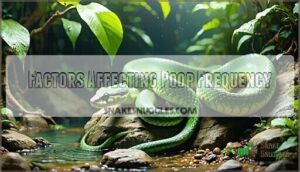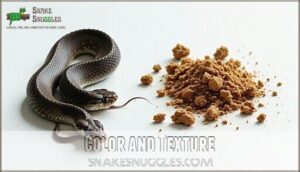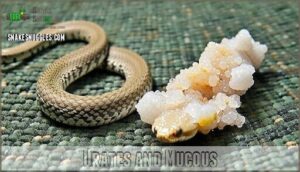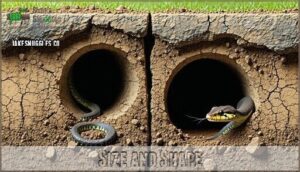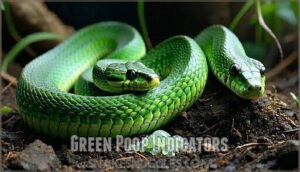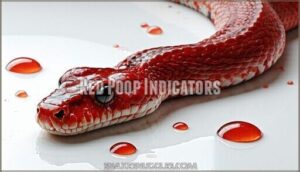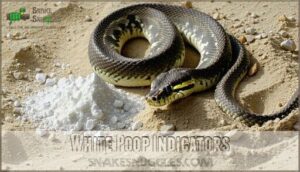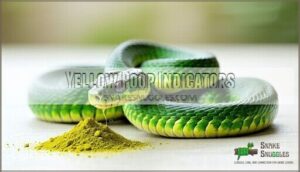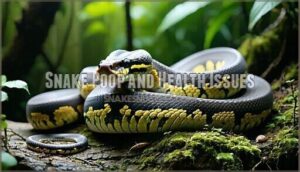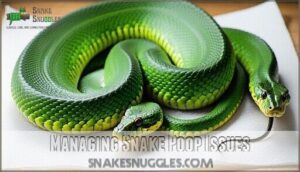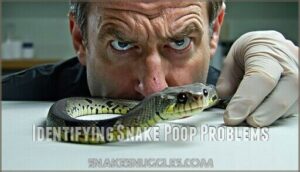This site is supported by our readers. We may earn a commission, at no cost to you, if you purchase through links.

Most snakes poop once every 1-4 weeks, depending on their size, species, and feeding schedule.
Unlike your daily bathroom routine, snakes take their sweet time digesting meals – sometimes up to 18 days!
Smaller species like ball pythons typically go weekly, while larger constrictors might wait a month between movements.
Your snake’s pooping frequency directly matches their eating pattern since they don’t snack constantly like mammals.
Temperature, hydration, and stress levels also play key roles in their digestive timeline, affecting both frequency and consistency patterns.
Table Of Contents
- Key Takeaways
- Snake Pooping Basics
- How Often Snakes Poop
- Factors Affecting Poop Frequency
- Normal Snake Poop Characteristics
- Abnormal Snake Poop Colors
- Snake Poop and Health Issues
- Managing Snake Poop Issues
- Snake Poop Frequency Variations
- Identifying Snake Poop Problems
- Maintaining Healthy Snake Digestion
- Frequently Asked Questions (FAQs)
- How often do snakes Pee?
- How often should a snake poop?
- How often do pythons poop?
- When do snakes poop?
- Do snakes poop?
- How long does a snake poop after eating?
- How long can a snake go without pooping?
- How often do snakes pee and poop?
- How long after eating does a snake poop?
- What do snake droppings look like?
- Conclusion
Key Takeaways
- You’ll see your snake poop every 1-4 weeks depending on their size, species, and feeding schedule – smaller snakes like ball pythons go weekly while larger constrictors wait up to a month between movements.
- Your snake’s bathroom habits directly match their eating pattern since they don’t snack constantly like mammals, and factors like temperature, hydration, and stress levels affect both frequency and consistency.
- You’ll recognize healthy snake poop by its two-part composition: dark brown or black cylindrical feces paired with chalky white urates, with size matching your snake’s body proportions.
- You need to watch for warning signs like unusual colors (green, red, or yellow), watery consistency, blood, or changes in normal patterns – these signal health issues requiring immediate veterinary attention.
Snake Pooping Basics
When you’re curious about snake bathroom habits, you’ll find that these reptiles have a unique digestive system that’s quite different from mammals.
Unlike your dog or cat, snakes use a special opening called the cloaca to eliminate waste, which combines both solid feces and white chalky urates in one convenient package, making their bathroom habits a notable aspect of their biology, particularly in how they utilize this system for unique waste elimination.
Snake Digestion Process
Your snake’s digestive system works like a slow-motion factory, breaking down entire meals over days or weeks.
Understanding this process helps you predict when your pet will need their "bathroom break."
Here’s how snake digestion transforms prey into waste:
- Enzyme Breakdown – Powerful digestive enzymes dissolve proteins and fats from swallowed prey
- Stomach Acidity – pH levels around 1.5 create an acidic bath stronger than car battery acid
- Intestinal Absorption – Small intestine extracts essential nutrients through specialized absorption processes
- Nutrient Processing – Liver and pancreas work together filtering and metabolizing absorbed compounds
- Waste Formation – Indigestible materials like fur and bones prepare for elimination through natural processes
Snake metabolism runs much slower than mammals, meaning your snake’s feeding schedule directly impacts their poop frequency and digestive timeline.
They eliminate waste through a multi-purpose cloaca.
Cloaca Function
Your snake’s cloaca is nature’s ultimate multitasker – handling reproduction, egg-laying, and waste elimination through one opening.
Your snake’s cloaca is nature’s Swiss Army knife—one opening handling all the messy business of life!
This remarkable organ features three chambers that separate different functions before everything exits together.
| Chamber | Function | Purpose |
|---|---|---|
| Coprodeum | Feces storage | Holds solid waste |
| Urodeum | Urine/reproduction | Processes liquid waste |
| Proctodeum | Final mixing | Combines all waste |
Understanding cloaca anatomy helps explain your snake’s unique bathroom habits and how the multitasker organ works.
Waste Composition
What comes out of your snake isn’t just a simple mess—it’s a three-part digestive masterpiece.
You’ll find dark fecal components mixed with chalky white urates (solid urine), plus occasional liquid urine and normal mucus.
Don’t panic if you spot bone fragments; they’re leftover digestive byproducts from prey.
This snake waste composition tells you everything’s working properly inside, indicating a normal mucus presence.
How Often Snakes Poop
Unlike mammals that hit the bathroom daily, snakes operate on a completely different schedule that’ll surprise you.
Your snake’s defecation habits depend heavily on their feeding routine, with most species pooping once every 1-4 weeks.
Adult snakes typically eliminate waste every 7-21 days, while juveniles go more frequently due to faster snake metabolism.
Here’s what affects your snake’s bathroom schedule:
- Meal intervals – They poop roughly once per meal consumed
- Digestion duration – Large meals take weeks to fully process
- Brumation effects – Winter slowdowns drastically reduce frequency
- Stress impact – Handling and environmental changes delay elimination
Snake poop frequency varies dramatically by species too.
Ball pythons usually go every 7-10 days after eating, while larger species like reticulated pythons might wait 2-3 weeks.
Your snake’s digestive system works at its own pace, so don’t panic if they skip a week.
Factors Affecting Poop Frequency
Your snake’s bathroom schedule isn’t as predictable as your morning routine, and several key factors determine how often they’ll need to go.
Understanding what affects their poop frequency will help you better monitor your pet’s health and know when something might be off, which is crucial for maintaining their overall well-being and health.
Diet and Species
What you feed your snake dramatically impacts their poop frequency.
Different species have vastly different dietary needs and digestion rates.
Ball pythons eating large rodents might poop every two weeks, while corn snakes on smaller prey defecate weekly.
Prey composition matters too—bony meals take longer to process than soft tissue.
Your snake’s feeding schedule directly determines their bathroom schedule.
Age and Size
Your snake’s age plays a big role in hatchling frequency and juvenile elimination patterns.
Young snakes poop more often than adults because their metabolism rate runs faster. Adult metabolism slows down substantially, creating snake poop frequency variations based on size correlation.
Larger snakes produce greater waste volume but defecate less frequently. Snake defecation habits change as your pet grows, with snake species differences affecting this natural progression.
Observing the snake’s urate composition and function can also provide insights into their hydration and kidney health.
Environmental Temperature
Temperature acts like your snake’s personal thermostat for digestion.
When it’s too cold, your snake’s metabolism slows dramatically, extending digestion time and reducing poop frequency.
Here’s how snake environment temperature affects their bathroom schedule:
- Optimal Temperature ranges boost snake metabolism rate and normal digestion
- Cold conditions slow snake digestion time factors substantially
- Brumation Effects nearly halt waste elimination during winter cooling
- Habitat Gradient allows snakes to regulate their internal processes
- Heating Methods help maintain consistent snake poop frequency variations
The provided list explains the impact of temperature on a snake’s digestive system, highlighting key factors such as Optimal Temperature, Cold conditions, Brumation Effects, Habitat Gradient, and Heating Methods.
Hydration Levels
Your snake’s hydration levels directly impact how often they’ll produce those telltale snake poop deposits.
Dehydration symptoms include thick, pasty urates consistency instead of the normal chalky white appearance.
Poor snake hydration leads to snake constipation and irregular snake bowel movements.
Soaking benefits include easier waste passage, while proper humidity impact and healthy drinking habits keep snake waste flowing smoothly, promoting proper humidity and healthy drinking habits.
Normal Snake Poop Characteristics
You’ll recognize healthy snake poop by its distinctive two-part composition: dark brown or black cylindrical feces paired with chalky white urates that look like small stones.
The size matches your snake’s body proportions, so don’t be surprised if your ball python’s droppings rival your dog’s while your corn snake produces tiny pellets, which can be considered complete concepts for understanding snake poop, and recognizing healthy snake droppings is crucial.
Color and Texture
Healthy snake poop color ranges from dark brown to black, with a firm, log-like consistency.
You’ll notice the feces consistency should be solid but not rock-hard. Snake poop texture appears smooth and cylindrical, resembling small sausages.
Abnormal textures like runny or crumbly droppings signal potential health issues. Always monitor your snake’s poop appearance for identifying issues early.
Urates and Mucous
White chalky chunks mixed with your snake’s poop aren’t cause for alarm—they’re urates, basically solid urine made from congealed ureic acid.
You’ll also notice mucus coating the waste, which helps everything slide out smoothly.
- Urate Composition: Normal urates appear white to pale yellow and feel chalky or pasty
- Mucus Function: Clear or slightly cloudy mucus lubricates waste during elimination
- Discolored Urates: Bright yellow, orange, or green urates may signal health issues
Size and Shape
You’ll notice your snake’s feces dimensions vary dramatically based on their size and recent meals.
Snake poop consistency resembles small logs with a smooth, cylindrical snake waste shape.
Large pythons produce waste comparable to dog droppings, while smaller species create tiny pellets.
The snake waste size directly correlates with prey size and snake feces width.
This correlation is essential in understanding the eating habits and health of your snake.
| Snake Size | Feces Dimensions | Log Shape Characteristics |
|---|---|---|
| Small (1-3 ft) | 0.5-1 inch long | Thin pencil-like cylinders |
| Medium (3-6 ft) | 1-3 inches long | Thumb-width logs |
| Large (6+ ft) | 3-6 inches long | Dog-sized droppings |
| Giant species | 6+ inches long | Exceptionally thick logs |
| Hatchlings | Under 0.5 inch | Tiny pellet formations |
Snake poop appearance includes white urates consistency mixed throughout, with occasional mucus presence creating a slimy coating.
You might spot prey remnants like fur or small bones embedded within the waste.
These characteristics help in identifying the type of food your snake has consumed and its overall digestive health.
Abnormal Snake Poop Colors
When you spot unusual colors in your snake’s droppings, it’s like getting a colorful warning flag about their health status.
These abnormal hues—whether green, red, white, or yellow—can signal anything from minor digestive issues to serious medical conditions that need immediate attention.
Green Poop Indicators
Your snake’s poop turning green isn’t cause for panic, but it’s definitely worth investigating.
Green reptile poop often signals liver function problems or bile issues affecting digestion.
Infection signs include persistent green coloration, while fasting effects can temporarily alter snake poop color variations.
Dietary causes like high-chlorophyll prey may create green snake poop abnormalities too, which can be a sign of digestion problems.
Red Poop Indicators
Bright red snake poop signals serious trouble – think internal bleeding or intestinal trauma.
Parasite infestation can cause bloody droppings, while dietary causes like consuming high-blood prey might temporarily alter color.
However, persistent red snake poop abnormalities indicate trauma signs requiring immediate veterinary diagnosis. Don’t wait – red snake poop concerns demand professional snake health evaluation within hours.
White Poop Indicators
Excessive snake poop white coloration typically stems from dehydration affecting urate composition or kidney function issues.
When your snake’s waste appears chalky white throughout, it signals potential metabolic problems beyond normal snake urates.
Calcium excess from bone digestion can temporarily whiten droppings, but persistent white snake excretion warrants veterinary attention since dietary influence alone rarely causes such dramatic snake waste changes, indicating possible kidney function issues.
Yellow Poop Indicators
Yellow snake poop signals serious health concerns you shouldn’t ignore.
Liver dysfunction and bile issues often create this alarming coloration, differing from normal pale urates.
Dietary influence plays a role, but persistent yellow indicates parasitic infections or metabolic problems.
Professional snake poop analysis becomes critical when you notice this color change during routine snake excretion monitoring.
Snake Poop and Health Issues
You’ll want to watch your snake’s bathroom habits closely since changes in pooping patterns often signal health problems like constipation, impaction, or dehydration.
Think of it as your snake’s way of sending you a health report card—irregular schedules, strange colors, or runny consistency can mean it’s time for a vet visit to check for issues like dehydration.
Constipation Causes
Poor snake care often triggers constipation in your slithery friend.
Dehydration risks increase when water bowls run dry, while low humidity levels make matters worse.
Your enclosure setup matters too – inadequate temperatures slow the snake digestive system substantially.
Without enough dietary fiber from whole prey, waste becomes harder to pass, creating uncomfortable blockages that require immediate attention.
Low humidity can also lead to difficulty shedding skin, which is a significant problem in snake care and can cause discomfort.
Impaction Risks
Impaction occurs when your snake’s digestive system becomes completely blocked, creating a medical emergency requiring immediate attention.
Unlike simple constipation, snake impaction often needs surgical intervention to remove obstructions.
Substrate ingestion and oversized prey are common culprits, and preventative measures include proper feeding protocols and safe substrate choices to protect your snake’s digestive system, watching for impaction symptoms like prolonged appetite loss and visible swelling.
Dehydration Effects
When your snake’s fluid intake drops, everything gets backed up like rush hour traffic.
Dehydration wreaks havoc on the snake urinary system, turning normal urates into chalky white rocks. Your snake’s kidney function struggles, creating shedding issues and boosting constipation risk.
The snake digestive system slows down, making snake poop harder and less frequent. Sunken eyes indicate dehydration, a symptom that needs immediate attention.
Proper hydration keeps everything flowing smoothly, preventing issues like dehydration, constipation, and shedding issues, which can be critical for your snake’s health, and it is crucial to address them with proper care.
Managing Snake Poop Issues
When your snake’s bathroom schedule goes haywire, you’ll need to act quickly to prevent serious health complications like impaction or dehydration.
You can tackle most poop problems at home using simple techniques like warm water soaks, humidity adjustments, and dietary modifications, though severe cases require immediate veterinary attention.
Soaking and Hydration
When your snake’s struggling with constipation, proper hydration becomes your best friend.
Soaking benefits include softening waste and providing essential snake hydration needs relief. Fill a shallow container with lukewarm water, ensuring good water quality.
This proper technique helps with dehydration while doubling as shedding aid. Regular snake soaks meet water requirements naturally, making bathroom breaks much easier for everyone involved.
To facilitate this, you might need a suitable soaking container to ensure your snake gets the proper hydration and care it needs for a healthy life, preventing issues like dehydration.
Dietary Changes
Adjusting your snake’s diet can work wonders for digestive troubles. Smaller prey items digest easier than oversized meals, preventing backup.
Switch up prey variety – rodents, birds, or fish offer different nutritional profiles. You can find suitable snake food online.
Review your snake feeding schedule too. Feeding less frequently gives their digestive process time to work properly. Sometimes dietary deficiencies cause irregular bowel movements, so consider supplementation needs.
Handling and Stress
Frequent handling can stress your snake and disrupt normal bowel movements.
Watch for stress indicators like defensive posturing, reduced appetite, or hiding behavior.
During shedding periods, minimize handling since snakes become more sensitive.
Each snake’s temperament affects how they respond to interaction.
Excessive stress from poor handling techniques increases regurgitation risk and can delay digestion, affecting their natural bathroom schedule, which is why it’s crucial to avoid causing excessive stress and to handle them with care to prevent disrupting their normal bowel movements.
Snake Poop Frequency Variations
If you’ve ever wondered why your ball python poops every week while your friend’s corn snake goes twice as often, you’re seeing species-specific differences in action.
Your snake’s bathroom schedule depends on factors like its species, size, environment, and even whether it’s feeling stressed from that recent cage cleaning, which can be a significant factor in its overall health and bathroom schedule.
Species-Specific Pooping
Different snake species have vastly different bathroom schedules.
Python defecation occurs every 2-3 weeks after large meals, while Boa elimination follows similar patterns.
Viper frequency varies dramatically – Bush Vipers poop almost weekly, but larger species wait longer.
Colubrid waste appears more regularly than python species.
Elapid habits depend on size and activity level, with smaller species eliminating waste more frequently than their heavyweight cousins.
Environmental Influences
Understanding your snake’s bathroom habits means recognizing how their environment shapes digestion.
Your snake’s enclosure directly impacts how often they’ll poop through several key factors:
- Humidity levels – Low humidity slows digestion and causes constipation
- Temperature gradients – Cool temps delay waste processing substantially
- Enclosure size – Cramped spaces increase stress, affecting bowel movements
- Seasonal changes – Winter-like conditions trigger slower metabolism
- Substrate type – Poor bedding affects comfort and elimination patterns
Reorganizing the paragraph structure improves readability by logically grouping complete concepts into separate lines, with double new lines to visually separate each group, as instructed.
Identifying Snake Poop Problems
You’ll know something’s wrong when your snake’s bathroom habits take an alarming turn, like finding watery diarrhea instead of solid waste or spotting bright red blood that signals internal bleeding.
Recognizing these warning signs early can mean the difference between a simple fix and an emergency vet visit, so don’t ignore changes in your snake’s normal pooping patterns, as this can be a sign of internal bleeding.
Regurgitation Vs Poop
Don’t confuse snake poop with regurgitation—they’re completely different processes.
Snake regurgitation happens when undigested prey comes back up through the mouth, usually due to stress or improper temperatures.
Snake poop exits through the cloaca after complete digestion, containing waste content and urates.
Regurgitation shows whole prey; poop shows processed waste with nutrient absorption complete, which is a result of different processes.
Diarrhea Causes
Several culprits can trigger snake diarrhea, turning your pet’s bathroom habits into a messy nightmare.
Parasitic infections from contaminated prey or poor hygiene top the list, followed by bacterial overgrowth in dirty enclosures.
Viral infections, though less common, also cause digestive chaos.
Stress factors like handling, temperature changes, or new environments frequently upset snake digestive systems, requiring immediate veterinary care.
A common cause can be rapid dietary changes, so be sure to introduce new foods slowly to prevent digestive issues.
Blood in Poop
Red flags appear when you spot fresh blood in your snake’s poop – this isn’t leftover rodent blood from dinner.
Bright red blood in snake droppings screams emergency – this isn’t dinner leftovers, it’s a vet-worthy crisis.
Internal bleeding in the lower tract creates bright red streaks or clots in stool, signaling serious problems like parasites or injury.
Don’t wait around hoping it’ll resolve itself, Immediate veterinary care is non-negotiable when blood appears.
Maintaining Healthy Snake Digestion
You’ll keep your snake’s digestive system running smoothly by focusing on three key areas: proper hydration, a balanced diet, and maintaining a clean environment.
Think of it like keeping a well-oiled machine running—when you provide consistent water access, appropriate prey sizes, and spotless tank conditions, your snake’s bathroom habits will stay regular and healthy.
Proper Hydration
Water sources are your snake’s lifeline for healthy digestion and normal bathroom habits.
Fresh water availability prevents snake dehydration, which directly affects urates consistency and makes elimination easier.
Proper humidity levels aid shedding and improve snake water requirements.
You’ll notice soaking benefits include softer waste passage and better snake urine concentration, reducing those rock-hard white chunks, with fresh water being crucial for healthy digestion and normal bathroom habits.
Balanced Diet
Feeding your snake the right balance transforms their digestive health dramatically.
You’ll need proper prey variety and nutrient ratios to keep things moving smoothly.
Consider gut loading feeder insects and matching food size to your snake’s girth.
Proper prey selection is essential for digestive health.
Snake feeding habits matter—supplementation needs vary by species, but most thrive on whole prey that provides complete nutrition naturally.
Clean Environment
Beyond proper diet, maintaining a spotless enclosure prevents bacterial buildup that disrupts digestion.
Choose absorbent substrate for easy snake waste removal, and establish regular snake enclosure cleaning schedules.
Remove waste immediately to control snake enclosure odor and maintain snake enclosure hygiene.
For ideal cleanliness, consider using a specialized cleaning product to support healthy snake waste management while preventing disease transmission that could affect your snake’s digestive health.
Frequently Asked Questions (FAQs)
How often do snakes Pee?
Like a silent river flowing through desert sands, snakes don’t actually "pee" like mammals do. Instead, you’ll see white chalky urates mixed with their feces, which eliminates liquid waste efficiently.
How often should a snake poop?
Your snake should poop every 1-4 weeks after eating, depending on its size and species.
Younger snakes defecate more frequently than adults, while larger species like pythons go longer between meals.
How often do pythons poop?
Pythons typically defecate every 2-3 weeks after eating, depending on their size and meal frequency.
You’ll notice larger pythons poop less often than smaller ones since they eat bigger meals less frequently.
When do snakes poop?
Picture your scaly friend finishing a satisfying meal—you’ll typically see waste appear within days to weeks afterward.
Snakes poop after digesting prey completely, usually matching their feeding schedule of every 1-4 meals consumed, which can be considered a satisfying meal.
Do snakes poop?
Yes, you’ll find that snakes definitely poop!
They excrete waste through their cloaca, producing brown feces mixed with white chalky urates.
It’s perfectly normal, though they don’t go as frequently as mammals.
How long does a snake poop after eating?
Your slithery friend typically takes anywhere from a few days to several weeks after eating to produce waste.
It depends on meal size, your snake’s species, age, and tank temperature—bigger meals mean longer waits.
How long can a snake go without pooping?
Adult snakes can go weeks without pooping, sometimes up to a month or more between meals.
Young snakes need to eliminate waste more frequently, typically every few days to a week after eating.
How often do snakes pee and poop?
Snakes typically poop and pee together every 1-4 weeks, depending on their species, size, and feeding schedule. You’ll notice both dark feces and white urates expelled simultaneously through their cloaca.
How long after eating does a snake poop?
Most snakes digest meals over 7-14 days before pooping.
You’ll typically see waste 1-2 weeks after feeding, though younger snakes defecate faster while larger species take longer to process their prey completely.
What do snake droppings look like?
You’ll recognize snake droppings by their distinctive two-part appearance: dark brown or black log-shaped feces paired with white chalky urates.
They’re solid, cylindrical, and may contain leftover prey bits like fur or teeth, which can help identify the type of snake and its diet, making urate analysis useful.
Conclusion
Understanding how often do snakes poop is like cracking the code to your pet’s health – it’s all about timing and observation.
You’ve learned that most snakes poop every 1-4 weeks, with frequency depending on species, size, and feeding schedules.
Remember, consistent monitoring of your snake’s bathroom habits helps you catch potential health issues early.
Keep providing proper hydration, maintain ideal temperatures, and don’t stress if your snake takes longer between movements – they’re just built differently than us!
- https://www.webmd.com/digestive-disorders/poop-chart-bristol-stool-scale
- https://vcahospitals.com/know-your-pet/snakes-problems
- https://sydneysnakes.com.au/what-does-snake-poop-look-like
- https://www.piedmont.org/living-real-change/what-your-stool-says-about-your-health
- https://www.vetlexicon.com/exotis/reptiles/gastrohepatology/articles/diarrhea


